Sometimes you just need a little, visible nudge to remind you of what is important to you. So this week – a downloadable poster. Print it out (up to 18 in x 24 in) and hang it up near your harp so you remember each time you sit. Yes it’s goofy – but if it makes you focus or makes you laugh, at least you’ll already be at your harp – so you might as well play a little. To get your copy – just let me know you would like to have it – leave me a comment and I’ll get it to you!
To get your copy – just let me know you would like to have it – leave me a comment and I’ll get it to you!
Category: Practice
-
Harp Room Bling
-
If it was easy, it would be easy!
I have told you before that I find many parts of making music are relatively easy. I would say that it’s easier to play the harp than to calculate cubic roots in my head or to determine the easiest way to teach unified field theory to toddlers.
But not everyone agrees – especially less experienced musicians who often express frustration and dismay over how hard it can be to play the harp.
To less experienced harp players, ease seems to be either a sadistic ploy to make them feel badly about their level of experience (it isn’t, I assure you – we’ve all been there at some point) or a cruel twist of fate that leaves some people finding it easy, with others finding it impossible. I will not take up the nature/nurture question vis a vis musicianship, but I will tell you something that will (upon reflection) not surprise you –
That apparent ease that you see in experienced players – especially in professionals – is a result of (you know what I’m about to say…)…PRACTICE!
The more you practice something – the more often you perform that skill – the easier it becomes. Continued, focused practice can result in the task itself becoming automatic. You can do that thing without even thinking about it. In fact, if you think about it, you may not be able to do it! The more you practice something, the less you have to consciously think about it to make it happen. And that comes about through practice.
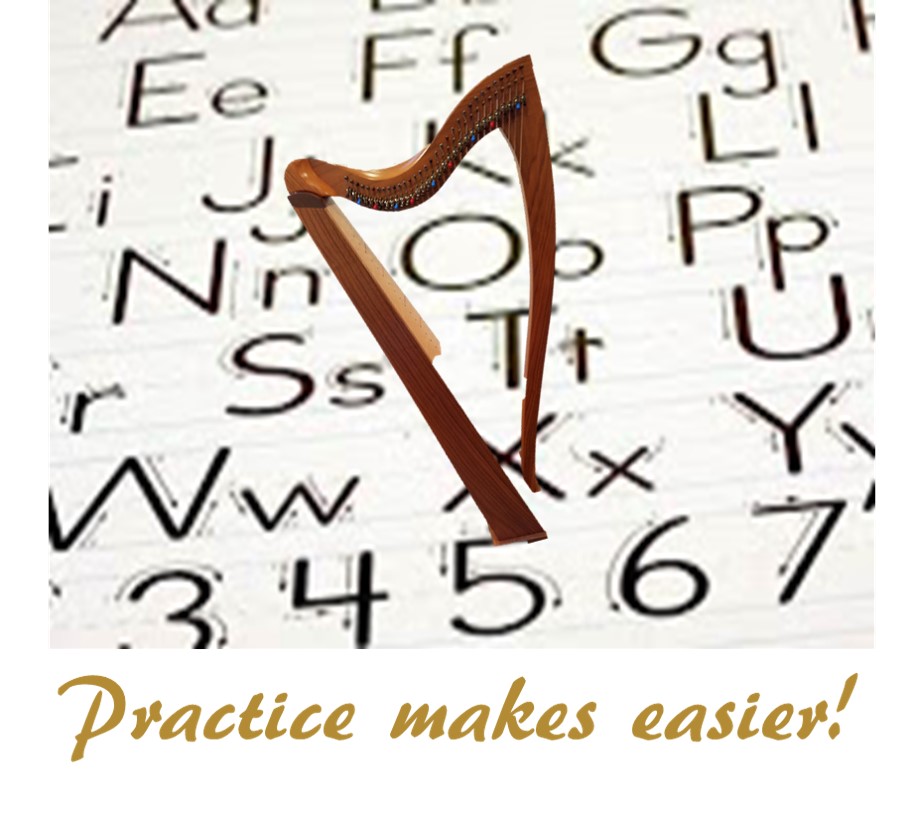 If you practice anything accurately you will become better at it (of course if you practice inaccurately, you will become better at doing something incorrectly!). If you practice counting, you will get more proficient at counting. If you practice reading you will become better at reading. If you practice making hand shapes and blocking, this will become second nature – it will become just the way you do it.
If you practice anything accurately you will become better at it (of course if you practice inaccurately, you will become better at doing something incorrectly!). If you practice counting, you will get more proficient at counting. If you practice reading you will become better at reading. If you practice making hand shapes and blocking, this will become second nature – it will become just the way you do it.Even beginners have developed some skills. If you’re more experienced, you have already mastered many activities and made them automatic. Complex tasks can like walking, jumping, writing, etc. all once required a great deal of concentration and effort but are now automatic. If you think this is not the case, I recommend you spend more time with very young children – you can watch them find behaviors and practice them. When walking is new, you don’t just wish to walk better – you walk and walk and walk, and fall down, and get up and walk some more – until you can do it all by yourself!
So, if you are working hard to play – whether it is counting, or blocking, having consistent fingering, sitting up straight, or reading – you now know that you just need more practice with those basic behaviors. Strong practice of these basic skills – making them automatic – frees up your brain to do other hard work, like learning new pieces, adding appropriate dynamics, or writing your own!
There are no short cuts. If it was easy, it would be easy. Now, go practice!
Are there things you find easy? Things you find difficult? What are they? Leave a comment below!
-
Better get moving – 10 steps to get ready for the holidays!
It’s nearly October (yikes!), the summer is over, the kids are back to school, the days are palpably shorter. And you know what that means – the holidays are nearly here!
There are only 12 weeks to go – but you know that festivities will start in about six to eight week so there will be plenty of time to fit in all the parties, pageants, festivals, parades, celebrations, get-togethers, gift exchanges, as well as gatherings. And each of those will be an opportunity to share one of your greatest gifts – your music!
Better get ready – but how? Here are ten (relatively easy) steps:
 First, manage your expectations. Be realistic. You might want to capture all the things you will be doing during the run up to the season as well as the season itself. You know you will have work and practice, and family traditions, and social events that you anticipate you will be part of. You can make a list or pencil them into your calendar or make a spreadsheet. What you really need to know is how much time you actually have. How much time do you really have to practice? How much time do you have to prepare? How much time do you have to share?
First, manage your expectations. Be realistic. You might want to capture all the things you will be doing during the run up to the season as well as the season itself. You know you will have work and practice, and family traditions, and social events that you anticipate you will be part of. You can make a list or pencil them into your calendar or make a spreadsheet. What you really need to know is how much time you actually have. How much time do you really have to practice? How much time do you have to prepare? How much time do you have to share?Second, manage other people’s expectations. If you want to be playing for others, let it be known so you might be asked. Not interested in playing for an event? Just say no. It is, however, the season for music and people will try to be persuasive (or maybe they will gently bully you into trying to get you agree). Worried about saying no? Ask someone you know who does want to be playing. Be prepared with their name and contact information. It will be a win-win-win: you don’t have to give a flat no because you have a referral ready (you win). The referred harper gets a gig they might not have been positioned for otherwise (harper wins). And the audience gets a willing performer (so they win too).
Third, make a list of the tunes you have played in the past. These will likely come back quickly and can be the backbone of your playing.
Fourth, make a “learn these” list of the tunes you want to play but haven’t learned yet. These will be work, but they will be worth it! Be reasonable given the amount of time you have to practice.
Fifth, if you will be playing for others, estimate how much music you will need. I usually guestimate about 6 – 8 tunes to 15 minutes. This might be conservative, but it assures that I don’t run out of music before I run out of time. I also suggest you build two set lists – because I like to be overprepared and having too much music means I can pick and choose once I get there depending on how the audience is responding. It also means that I won’t have to play something that feels shaky or just hasn’t come together enough yet. Remember that you can insert other music into the list – include the winter themed tunes or favorites to make an enjoyable performance. Especially later in the season, people will begin to fatigue of holiday music so some other tunes will wake them up and keep them engaged.
Sixth, now that you have a list and know about how many tunes you’re looking for, play through your old tunes and critically (but not harshly) determine what work is needed to get them up to scratch. Revise your list as needed (move anything that feels like it might be a train wreck to the “learn these” list).
Seventh, make a schedule to get the new music learned and ready to go and to make the old stuff polished and shone. This will be a plan to structure your practice between now and the holidays. Be realistic!
Eighth, schedule your practice time. Write it in your calendar. Make a date with your harp every day. Keep practicing your “regular” music too – although they come quick, the holidays are here and gone – so you might as well stay up to date for January!
Ninth, keep an eye on your plan and revise as necessary! Update your lists, adjust as needed, keep the end in mind. Remember the goal is to play well and feel comfortable when it’s time to play.
Finally, have fun! You’re going to make so many people happy when you share your gift – make sure one of those is you! The holidays are a time for joy – share yours!
Follow these ten steps and you will be well on your way to sharing your gift! How do you prepare for the holidays? Share your tips in the comments.
-
Expand your musical reach – another stretch (or 7!)
We have talked about stretching through making art and stretching our bodies. There’s another place we need to stretch and that is in our music. And it’s the perfect time to think about it – it will be the winter holidays and all the lovely opportunities to play will be coming. I mention the holidays because they are the perfect foil for stretching our music.
The holidays are great from a repertoire perspective. There is a relatively small set of tunes to work from and each year, those that have been on our set lists for a while seem to become easier to prepare and to play. It’s also easier to knuckle under and practice – we know it’s coming; we know we’ll be playing; and we know the bulk of what we’ll bring to each performance.
That doesn’t exactly sound like stretching.
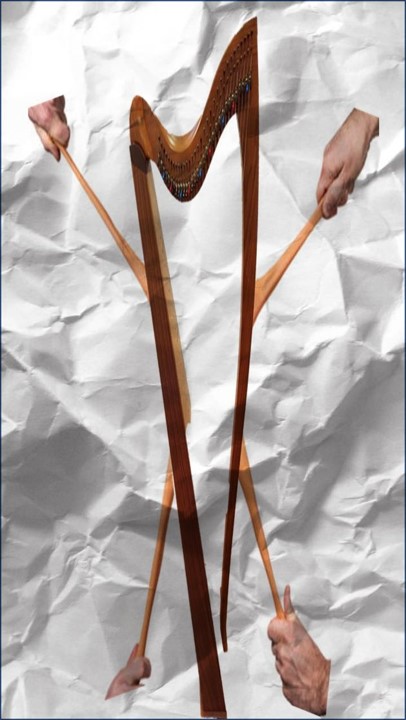 And that’s why it’s so great! There are loads of holiday tunes – so you probably don’t know them all. But you know some and so each year you can add another one or two to fill in your set list. But we have to fight the urge to be lazy and just play all the same stuff.
And that’s why it’s so great! There are loads of holiday tunes – so you probably don’t know them all. But you know some and so each year you can add another one or two to fill in your set list. But we have to fight the urge to be lazy and just play all the same stuff. I don’t know about you, but I really like hearing new (to me) stuff at the holidays. From countries whose music I don’t know well, from new sources, and from the set of those songs that hardly anyone records but are just so good.
So, the holidays are an opportunity to stretch ourselves – musically.
What does stretching musically mean? Trying new things! It can be adding techniques we don’t usually use, playing music we don’t usually play, finding stuff we didn’t know existed and fitting it into our lives, arranging music we like (from other instruments) and playing it on the harp, or more.
How is stretching musically good for us? Here are seven unsurprising ways (some of these might sound familiar since they are as with making art)
- Stretching is (still) the opposite of static! Static is not moving or changing. Static introduces b-o-r-i-n-g into your playing. It also means that you’re not growing as a musician. So, learn how to do some effect you think is cool…and actually use it in your playing! Do the work of technique practice. And after learning some new technique, actually add it to your playing!
- Stretching makes you more flexible. By adding new music, new sources, new techniques, new practice approaches, just new stuff to your playing, you will begin to explore yourself more and bring that into your playing and performance. And you will be free to do more than you thought you could when you were less flexible.
- Stretching helps defeat stress. The more you stretch your music, the more comfortable you become with playing it – because you’ll become more accustomed to being stretched. In your practice, in performance, in ensemble, in sessions – no matter where you’re playing you will be more relaxed, able to enjoy the process and product of making music. That comfort is an indication of your reduced stress.
- Stretching helps overcome pain and discomfort. You might decide to stretch your music when you feel the discomfort be becoming bored. Of course, once you decide to stretch your music, you might feel self-conscious, uneducated, or ignorant. The music activities that stretch you might make you feel uncomfortable in and of themselves. But keeping at it – a little bit each day – will help you be more comfortable and soon, you’ll be interested in the flexibility of trying new music. I’d suggest adding time for creativity in your practice each day so you will be able to stretch musically with less (perceived) “stiffness”.
- Stretching helps you focus. You can be mindful when you are stretching your music. Mindful of what it is about the music that attracts (or repels) you, what technique elements you need to work on, what your harp really shines with. In addition, a broader repertoire may help you to feel more accomplished and allow you to comfortably book gigs previously out of reach. Be sure to pay attention as you’re stretching your music to identify what to keep on doing.
- Stretching improves your range. As you add music to your toolbox, and include the listening, reading, technique and effects the new music might require of you, you will become more able to do more things with greater musicality – and add new things more quickly.
- Stretching stretches you. There’s nothing like playing something you never thought you’d be able to (or possibly even that you never thought about adding) to boost your confidence and encourage you to try even more new things!
Stretching – the gentle kind that broadens your abilities, and leaves you relaxed and enjoying making music, is just what you need. With these seven stretches you might become a better musician! What kind of music might you add to stretch yourself? What else might you do to stretch yourself musically? Tell me in the comments – I can’t wait to hear!
-
In the Bleak Mid-Summer…8 ways to stay Motivated
It is the Bleak Midsummer – that time of year when it might as well be winter for all that you intend to go outside! It’s predicted to be about 100o tomorrow – ugh. And raining. The remnants of a tropical depressed (yes, I meant that).
Of course, it will be pouring while I try to load my car to head to Somerset Folk Harp Festival. Why does it always rain when you need to load your harp into the car? It’s just a law of nature I supposed.
 But that’s the thing about the Bleak Midsummer (you might call it the Summer Doldrums, but that’s not bleak enough for me) – the heat, the humidity, the knowing that it will last another eight weeks – all gang up on you and sap your strength and motivation! Who wants to play when you know you’re going to sweat on your harp?
But that’s the thing about the Bleak Midsummer (you might call it the Summer Doldrums, but that’s not bleak enough for me) – the heat, the humidity, the knowing that it will last another eight weeks – all gang up on you and sap your strength and motivation! Who wants to play when you know you’re going to sweat on your harp?Ugh.
So, how do you stay motivated? Here are 8 ways that might work for you:
- Go to summer harp events! I’m delighted to be going to Somerset Folk Harp Festival and I’m missing all the fun we had at the Ohio Scottish Arts School, and I’m really looking forward to Harp Quest! I wish I was able to fit more in, but these events (and others like them) really help you break out of any rut you might be in, let you catch up with old (but distant) harp friends, make new harp friends, and learn a lot in a relatively short time. Best of all, you come home with new tunes, cool tricks and tips, and usually a bounce in your harp-step! [BTW -There only a few remaining spots in Harp Quest and registration will close soon, so be sure to get in while there’s space! More info here or contact us here]
- Use the long days to your advantage – if you normally practice in the evening, you can use the early light to get a new view on your playing. Never gonna happen that you get up at 5 to practice? No worries – enjoy practicing in the late afternoon or early evening – here too the light is so bright and the sun still so high that it feels like you’re practicing much earlier than you are. Or wait until the lingering sunsets of summer to enjoy the feel of playing the evening in. No matter what, you can use the longer days to get a fresh perspective on your playing.
- Don’t let the short nights get the better of you – be sure you’re still getting enough sleep. Getting enough sleep will not only help you play better but will also help stave off the blues. Those long nights will be upon us before we know it (even if it feels like they’ll never come) but you can still arrange to get plenty of rest.
- It’s VACATION TIME! You can take this a number of ways. You’re going to go away and have a frabjous time somewhere else doing nothing (including not playing). Or you’re going somewhere amazing and taking your harp with your time away. Either way – use the down time to rest and recover. And maybe devote a few quiet moments to reminding yourself of how much you love playing the harp and that the work is just a path to enjoyment. [And if you want to plan ahead – you could never go wrong spending your vacation on a trip with us! Harp the Highlands and Islands 2020]
- Use those long sunny (hot) days to spend time in your favorite chair with your favorite libation thinking about how lucky you are to play the harp! That should perk you up and make you want to play (and maybe even to practice?). Of course, that libation should be part of your hydration plan – it’s so easy to get dehydrated in the summer and that will throw you off your game, sap your motivation, and probably give you a headache – all no fun.
- Think about Christmas – every year Christmas comes racing up and we’re never really ready, so give it a little thought now. Maybe plan out your cold weather strategy while it’s still nice and hot. When will you start? What tunes are you going to add this year? What have you played in the past that needs more work (and inevitably, more than you think)? Where are you going to play? What non-holiday tunes will you keep in the rotation to avoid boring the socks off your listeners? See, there’s loads to think about, while you’re sweating and not wanting to play.
- Just sit for 15 minutes. Promise yourself that you’ll only play for 15 minutes – after all, it’s hot and you won’t be able to concentrate for too long, so don’t think you will – just do it in bite sized chunks throughout the day.
- Have ice cream. Really? You’re going to question this? Fine, I’ll have yours.
Power through – it’ll be autumn soon and before you know it, we’ll be complaining about how cold it is! There’s eight ideas – do you have others? How do you stay motivated throughout the summer? Leave me a comment and share!
-
Now what?
Hopefully you believed me and at least started making your index card file. If so, you’ll have started the cards going, and once you’re caught up, adding your new material will require a less herculean effort!
But you’ve asked – now what? What are you supposed to do with this?
Well, there’s a reason I suggested this card catalog rather than just a list (however, if you opted for a list, that’s ok too – keep reading, it’s down below!). If you’ve made a card catalog, no matter if you are sorting by title or by tune type – you should also include another set of divisions:
Know | Don’t Know | Needs Polish
(you can also add additional dividers if you want to be more specific or to fit the way you think about it)
At each practice, you can pull the cards you need. Clearly, you will put the things you are actively working (from the “Don’t Know” section). The tricky bit is what else to pull. It is tempting to think the “Needs Polish” should come out infrequently, but you’d be wrong. These should be in your regular rotation for practice.
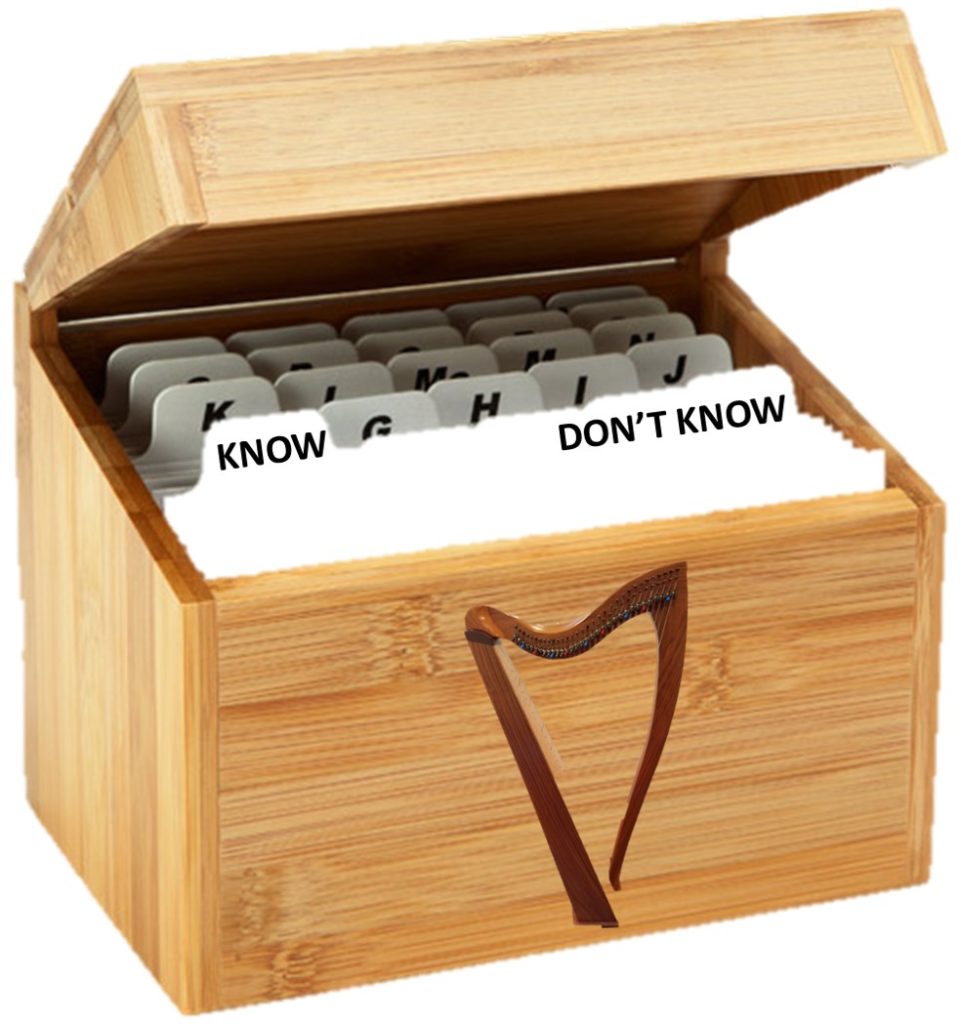 “Needs Polish” is code for, “I’d like to think I know this, but if push came to shove, I’d have to admit that I don’t really know it cold”. So, add those tunes to your regular practice. Also acknowledge that “Needs Polish” may be the weirdest/broadest category, so don’t despair. You will get there if you keep working on these tunes!
“Needs Polish” is code for, “I’d like to think I know this, but if push came to shove, I’d have to admit that I don’t really know it cold”. So, add those tunes to your regular practice. Also acknowledge that “Needs Polish” may be the weirdest/broadest category, so don’t despair. You will get there if you keep working on these tunes!But how do you use the “Know” cards? Pull one at random from the box at each practice. Play the tune and see how it goes. If you play it well – Yea! and put it back into the box. If it is wobbly when you play it, it goes into the “Needs Polish” section so you can get it back to scratch. And if it is a struggle (or you don’t remember large chunks of it*) put it back into “Don’t Know”. The number of “Knows” you pull out in each practice is up to you (and typically based on how much time you have each day).
If you’ve made a list (or set of lists) here are some other ideas. I’d suggest you use a spreadsheet (so you can move tunes easily from one section to another), but any format that works for you is the right one! You’ll still need to identify your categories and all that is above still applies. When it comes to choosing a tune from the “Know” pile, just close your eyes and point to a title. Or use a random number generator. Or roll some dice. Whatever works – just so you can select a tune to include each day.
No matter if you make cards or lists, you might want to make another, more flexible category and label it ❤ – these are the tunes you’re currently in love with (or just infatuated). We all have them. They are like summer loves – they make your heart go pitter pat just thinking about them. You play them obsessively and to the exclusion of many others. They quickly make the “Know” category. You can even put a ❤ on the card – you love them that much! I suggest this because, as so often happens with summer loves, they flame out quickly, only to be forgotten. When you pull one of these out, it is fun – like pulling out old summer photos. You can play these with a bit of wistfulness, and a chuckle at what you had become so obsessed with at the time. Some will make it back into your repertoire which will be fun. And even if you don’t put it back into your regular repertoire, it will be fun to see how you’ve grown!
You need to manage the number of pieces you’re working on at a time. It is very easy to attempt to work on too many tunes (especially after a great summer event like Ohio Scottish Arts School when you come home with boatloads of new tunes!). You want to work on them all – but you need to pace yourself or you’ll end up with nothing. Using the cards gives you an easy way to keep track of what you need to work on, what you need to polish, what you need to review, and what you want to get to soon.
If you make a plan for each practice you will be able to add tunes, move them along in learning and make strong additions to your repertoire. What are you adding right now?
-
Stay between the lines!
I was driving down the highway the other day. I was going about 1000 miles, so on one particularly long, straight stretch, I started remembering when I learned to drive.
For me, one of the hardest things to learn was staying in the middle of the lane. When you start to drive, you know you need to stay in the lane – and between the lines. The lane is defined by the lines, so I looked at the lines – constantly. But you know how that goes – the more you look at the lines, the farther you are from your desired position – in the middle of the lane. The best advice (or training) I got was to look down the road – look way down the road. After I (finally) learned that, staying in the lane was so easy. Now, as an experienced driver, I don’t even see the lines close to me and keeping the vehicle in the middle of the lane is something I take for granted. It seems that I just go where I meant to be.
The reality is, no matter how good a driver you are, you will never stay in your lane to get where you’re going if you don’t look ahead. So, what does that have to do with playing the harp? Everything!
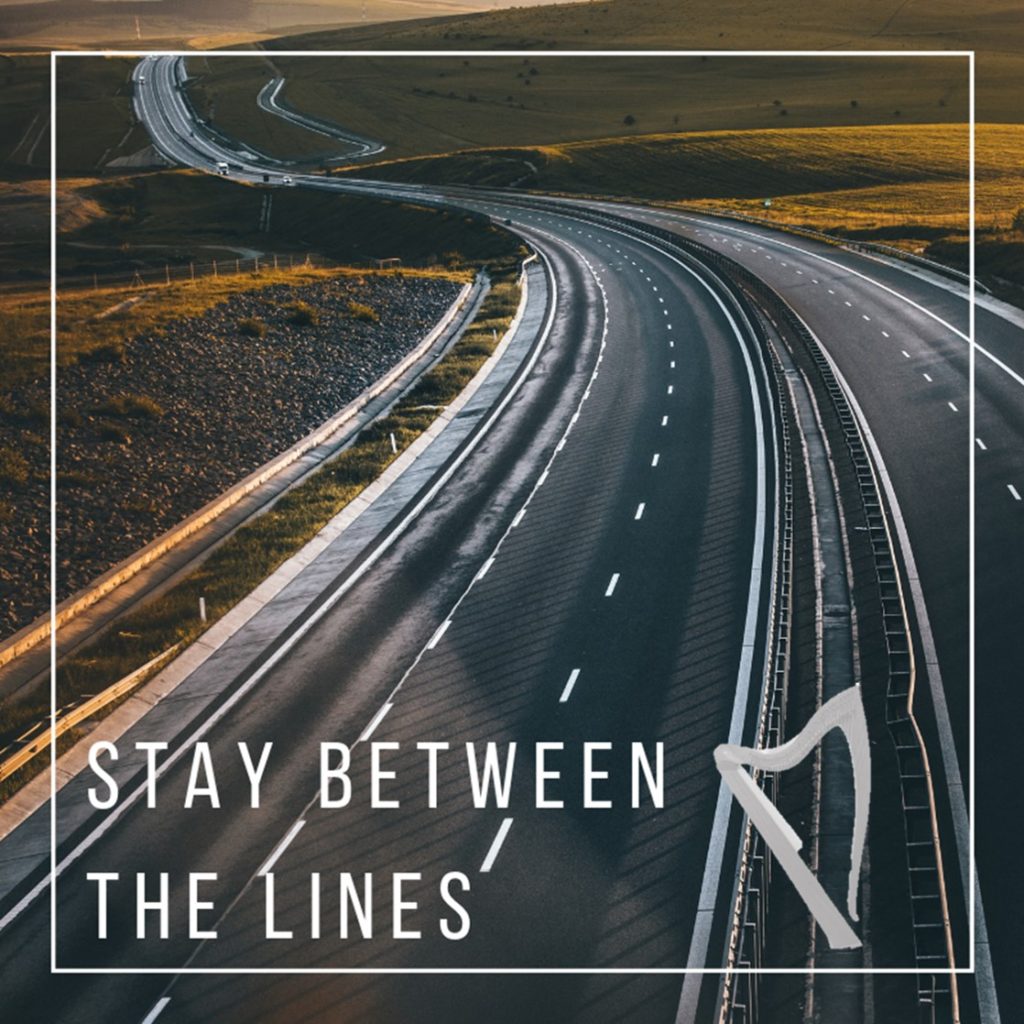 When you’re learning a new tune – what do you do? I don’t know about you, but when I’m having trouble getting a tune into my head, I naturally narrow my thinking down to just what comes next – what’s the next note. But this doesn’t actually help me learn the tune. It just frustrates me (thus drawing my focus away from what I’m trying to do – learn the tune). If I lift my head and keep my focus “down the road”, then I can think of the phrases (as phrases, not as a trickle of sounds). When I can hear the tune in my head, the notes that come next become so much easier to remember.
When you’re learning a new tune – what do you do? I don’t know about you, but when I’m having trouble getting a tune into my head, I naturally narrow my thinking down to just what comes next – what’s the next note. But this doesn’t actually help me learn the tune. It just frustrates me (thus drawing my focus away from what I’m trying to do – learn the tune). If I lift my head and keep my focus “down the road”, then I can think of the phrases (as phrases, not as a trickle of sounds). When I can hear the tune in my head, the notes that come next become so much easier to remember.When you’re reading music, the notation (the lines and everything else) are helpful – but can be distracting. Again, sometimes just having all that ink only serves to draw your attention to the individual blops – and you lose track of where you are on the page, in the phrase, in the music. When you lose your place, your hands may not end up in the right place, or they might be going the wrong direction or be overstretched! Keeping the long view will allow you to read the music rather than focusing on the ink and better allow you to be more able to play.
When you’re playing, you have learned the tune or become familiar with the dots on the sheet. When you’re playing, you want to be “in the moment” – and that is important. But remember that music isn’t static or fixed. Music is serial, it comes out over time – like the road! It can’t come out all at once (although there are some composers who clearly do not agree with me on that!). So being in the moment has to include the plans for this moment, and then for the next moment, and then the following moment, and on and on until the end of the piece – as a flow. This is not contradictory, rather, you need to hold the music in your head as a piece rather than as a set of notes. Looking at the whole of the music, rather than on just it’s representation (that you learned or are reading), will help keep you on track.
When you’re performing, you really are taking all that you have learned and putting it out there in the world to share. This is more than just playing in that now. Because now, in addition to being in the moment with the music, you must also be present with the listeners. Whether there are 2 or 200 or 2000 in the audience, your focus has to be “farther down the road” to include not only the music but also the hearers and what your message to them/with them is. Here, your long view includes them, the music, and the presentation. Keeping an eye on where you want to take them with the music, what it is you want to share, and how you mean to do that will help give you a smooth ride.
Of course, this is a simple analogy. There are many things on the road that require attention (like stop signs, traffic, pedestrians, etc.). And just like that, music (written or aural, practice or performance) has details (like dynamics, tempo, timbre, etc.) which enrich the ride and improve the experience. But, just as staying between the lines becomes second nature, learning, reading, playing and performing can also become second nature so that your music grows, flourishes, and delights. And just like any journey, when staying between the lines comes naturally and effortlessly, you can enjoy the journey so much more easily. What are the lines you have a hard time not looking at? How do you stay in the lane? When you look down the road – what do you see? Leave me a comment and share how you do it!
-
Permission Granted x20
Playing the harp is more challenging than it looks. You already know that. That’s why we work hard during practices. It’s why we try to practice regularly – so that we enjoy small, incremental improvements each day. And this is one reason I’m always suggesting that we track our progress – to acknowledge, accept, and grow from that practice.
Practicing certainly gives us a way to work on the technical aspects of playing, but there is so much more to playing – things that go beyond the technical. However, to get to those things we sometimes need to get out of our own way.
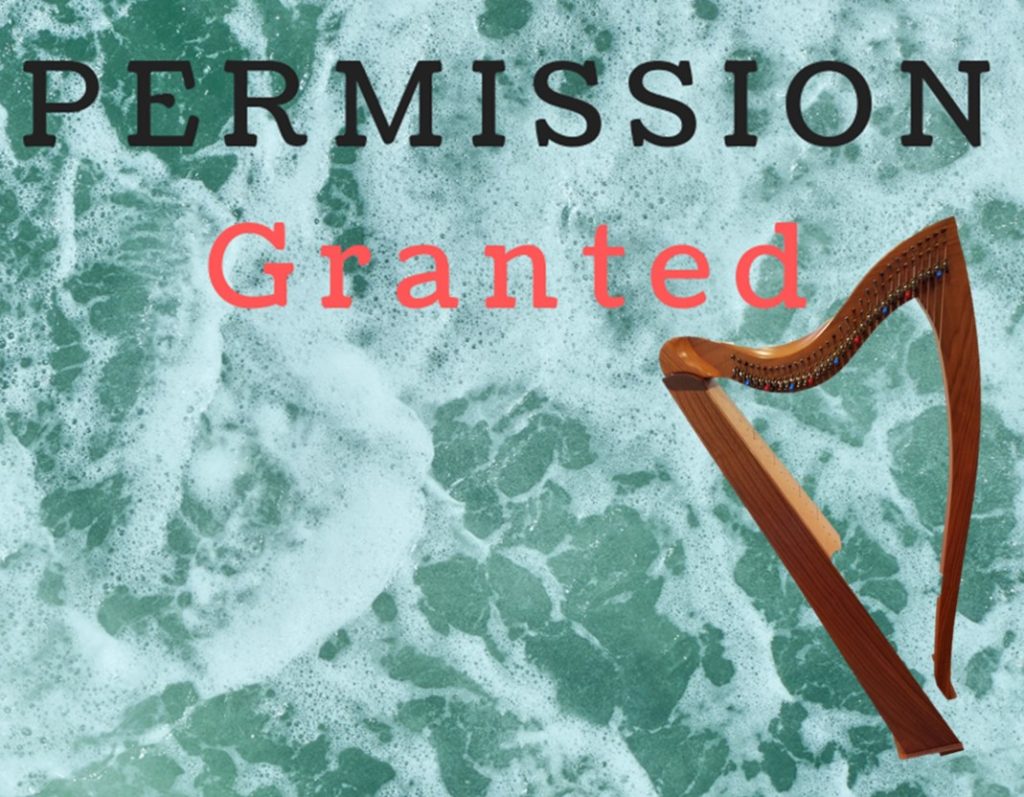 So, how do we do that? We start by giving ourselves permission. Permission for lots of things. But mostly, you have to give yourself permission to be YOU!
So, how do we do that? We start by giving ourselves permission. Permission for lots of things. But mostly, you have to give yourself permission to be YOU!Here are 20 types of permission you might consider giving yourself:
- Permission to fail. It happens. Actually, if you’re learning, you’ll fail a lot on the way. But if you refuse yourself the opportunity to fail, you won’t learn…and that would be a shame.
- Permission to be silly. There is so much seriousness in music, but a little silly will probably help you enjoy more.
- Permission to give it rest. Sometimes you need to percolate – and taking a little break will give you the option to do just that.
- Permission to be as good as you are (and no better). You are where you are. Be there.
- Permission to work on just one thing (until you get it right). Sometimes we think we have to master everything, all at once. But this doesn’t really do much except frustrate you.
- Permission to do scary things. When you scare yourself, you learnt that it didn’t kill you to try something new. We’re usually most scared that we will embarrass ourselves – you’re going to embarrass yourself one way or another, so embarrass yourself your own way!
- Permission to get out there and share. We often huddle in the safe cocoon of our harp room at home. But the music is best shared – so get out there!
- Permission to fail again (and again and again and again). You can’t just stop at one failure – do it over and over and over – and each time you’ll learn more that you can apply to the next failure.
- Permission to make art in multiple ways. This can be as small as playing a new kind of music or as big as learning to sculpt or paint or write. All your art will work to help you in the others.
- Permission to create “first drafts” (and second and third and on and on as needed). You know that what you see on stage or on YouTube is not spontaneous, right? So why do you expect your initial efforts to be performance ready? Think of the pre-work as your “drafts” that you will continue to refine and develop – until they are ready to share.
- Permission to have fun. Ok, this is pretty self-explanatory!
- Permission to laugh at yourself. No really, you should be able to laugh at yourself. Keep it light – it’s not rocket surgery after all.
- Permission to expect more from yourself. You don’t have to be content with your lot – you can want more (as long as you’re willing to work for it).
- Permission to be good at some things, not good at some others, and even to be terrible at a few. Here’s an example – I’m good at playing the harp, I’m not as good at cooking and I’m terrible at gardening. I’m ok with that – I allocate my time and resources accordingly (e.g., I practice for hours, I heat soup for dinner, and I pay a kid in the neighborhood to tend the garden – that’s that sorted!).
- Permission to practice as much as you need – and no more. I know some of you struggle to get your butt on the bench, but others spend too much time there – practice while it’s productive, and then go do something else. Got a deadline? Try a little practice multiple times in the day.
- Permission to be happy with where you are. This might seem counterintuitive (or counter to development) but it’s not – you are where you are. Be there. Right then. Realize too that time is a river – there is only constant change and you are changing when you are where you are – give yourself permission to accept that.
- Permission to want more. You think I’m contradicting myself – but remember I said there is constant change – if you want more, want it – and work for it!
- Permission to change your mind. Playing classical music and tired of it? Trapped in session tunes but longing for something more “substantial”? OK. It’s ok to change your mind about what you want to play. Just do it.
- Permission to keep track of what you are doing…and what you want to do next. However, you need to – keep track in your own way and build on that.
- Permission to spend your valuable time doing what you love. After all, time may be your most precious commodity – so spend the time you have doing what you love.
There are plenty of permissions to give yourself. What other ones do you give yourself (or do you need to give yourself)? Share that in the comments!
-
Planner vs Journal: What do you need?
You have endured my repeated suggestions that you keep a harp practice journal. I hope you have taken me up on my suggestion and that, in so doing, you have begun to understand why I make the suggestion. I also hope you saw, in short order, how the act of journaling can help you become a better harper. Simply by entering the conversation with yourself, you are able to capture your thoughts, feelings, successes, plans/goals and good ideas. And with review (or just idly flipping through) you can get an appreciation of all your hard work (and maybe a glimpse of the work you would be well advised to undertake – later…in the future….let’s not get too crazy!).
Recently, one of you asked about using a practice planner as a journal. Well, a planner is different from a journal, so today, some thoughts on each and an insight into how I (try) to use these with my students.
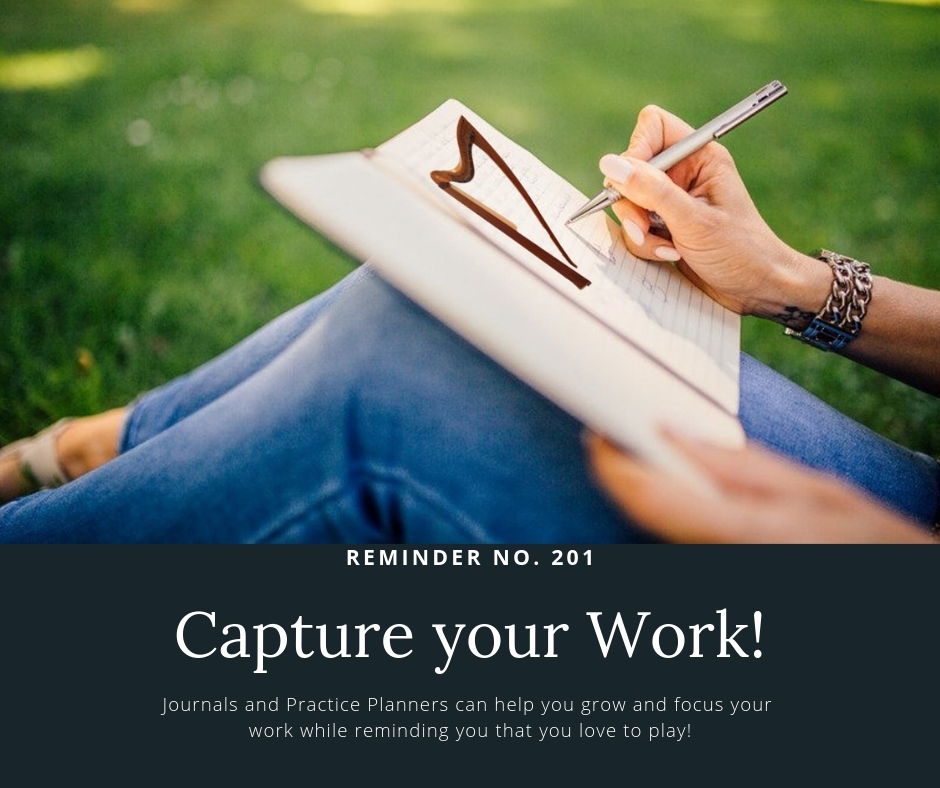 Planners and Journals serve two different functions. A Planner is forward looking, capturing what you should be working on, and how to schedule it all into your practice time (by the hour, the day, the week, the month, the season, the year, etc.). It describes what your teacher (or you, if you are actively using it) would like you to work on so that you continue to grow and so that you build the skills needed for the repertoire you will attempt in the future. It helps to organize your time spent and usually includes short term goals (which are actually criteria that, when reached, indicate readiness to move forward).
Planners and Journals serve two different functions. A Planner is forward looking, capturing what you should be working on, and how to schedule it all into your practice time (by the hour, the day, the week, the month, the season, the year, etc.). It describes what your teacher (or you, if you are actively using it) would like you to work on so that you continue to grow and so that you build the skills needed for the repertoire you will attempt in the future. It helps to organize your time spent and usually includes short term goals (which are actually criteria that, when reached, indicate readiness to move forward).A Journal, on the other hand, is, by definition, a retrospective of your work – mental, physical, emotional, and more. It can incorporate external factors (e.g. “I didn’t practice all week because I was on a cruise, but when I returned, I was delighted to be behind the harp once again and I quickly conquered my new tune that I was having trouble with before” or “I had a terrible week at work and I just didn’t feel like practicing which explains why I haven’t made progress with my tunes this week, but next week should be better!”). You write in your Journal after you practice or play, while reflecting on what happened, why, how you feel about that, and perhaps what you’d like to add to your planner (to avoid a negative or to reinforce something you see needs shoring up). And of course, you will, on occasion, go back and read through your thoughts and feelings to rediscover items that have fallen through your mental cracks.
A practice planner should be very clear and detailed – a set of instructions for the week. What (specifically) should you be focused on? At what point, then, do you move on for the next time? How many times to do the scales? In which key? What are your warm-ups this week? What skill builders will you do? What musicality exercises will you work on? How do you know when to stop? How good is good enough? What is expected of you in the practice time allotted?
A journal allows you to express your assessment of your practice time and your ideas on your progress (NB – this is NOT a platform for your inner critic! Rather you are capturing your opinion in a constructive way, so you can grow from it). You might include thoughts like “although I thought I’d never “get” those funky chord exercise note progressions, with three days of focused attention, I do “get” it and can now focus on the technique work that the exercise is needed for”. A little work, a little assessment, a little reflection, a lot of growth! You are also not limited in how you might capture those thoughts, reflections, and feelings – write, jot, paint, whatever will help you remember later on.
So, which should you have? A Planner or a Journal?
You need the Planner and the Journal! The real question is – in what form? The right answer is – in the form that works for you!
You can use simple planner sheet (want a free one? Subscribe here!) and a journal book. Then you have two things to work together to suggest your practice time. You want (and need) order and structure for the planner, so that the homework notes from your lesson help you to structure your practice time and to prepare for your next lesson. But you also need and want the freedom to capture your thoughts as they come and as they are best expressed. If you’re lazy like me, you want to have it all in one place. I prefer this for my students because it also provides a continuity to our discussion from lesson to lesson – one place for all thoughts.
Are you already journaling? Using a practice planner? What’s your method? And if you’re not, what’s stopping you? Journals and Practice Planners can help you grow and focus your work while reminding you that you love to play! No matter what form it takes, there is a lot of potential in writing it down. You can do this yourself – just get a notebook and start writing. But if you’d like a bespoke one, I can help you with that too – just leave a request in the comments and I’ll get back to you with details.
-
We’re all made of Stories – The Comparison Trap
We humans observe…and then compare. We are always collecting data about the world around us, analyzing it, and then selecting a winner. We have a classification scheme for winners and not winners – so we see where we rank in there.
This comparison trap is insidious in two ways. It assumes that you are an unbiased (and knowledgeable) arbiter of truth and it rarely takes context into account.
And typically, when we make comparisons, we find ourselves wanting.
Finding yourself wanting is not motivating.
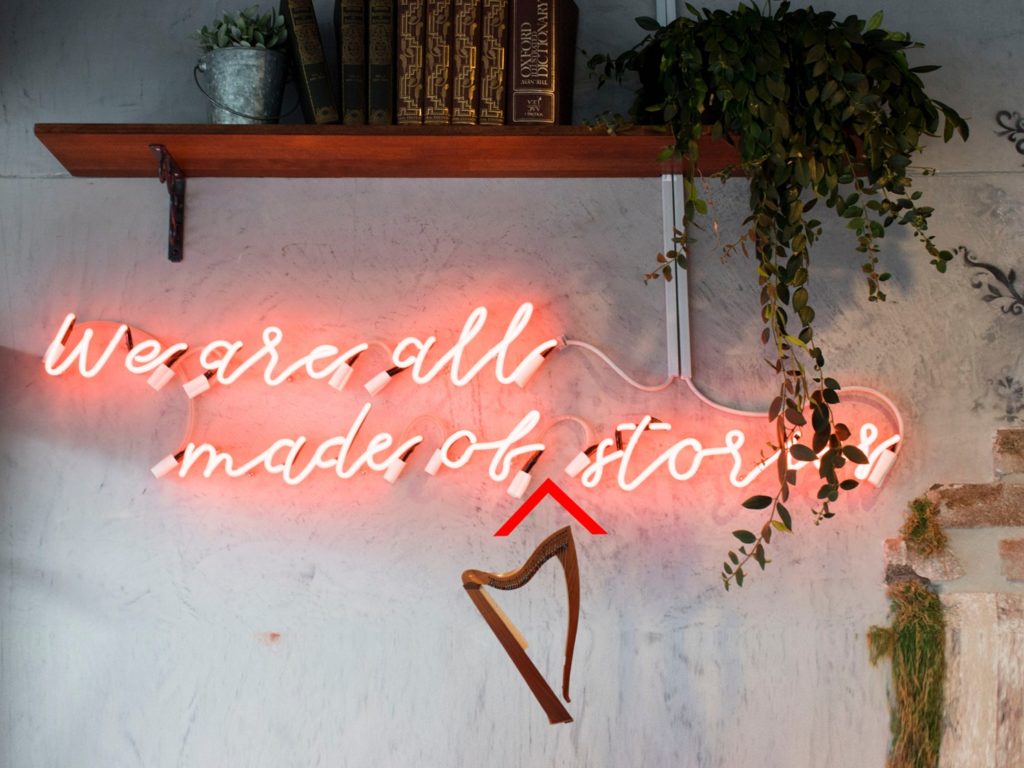 Are you a “Fair Witness” *? Are you certain that you are qualified to critique the performance of others relative to your own? And can you say, perhaps with more certainty, that you are qualified to evaluate your own performance – clear eyed and unbiased? Are you a Fair Witness to yourself that you can only report the truth with no trace of bias? Likely not – you have a vested interest in the outcome, so be honest about your ability to assess.
Are you a “Fair Witness” *? Are you certain that you are qualified to critique the performance of others relative to your own? And can you say, perhaps with more certainty, that you are qualified to evaluate your own performance – clear eyed and unbiased? Are you a Fair Witness to yourself that you can only report the truth with no trace of bias? Likely not – you have a vested interest in the outcome, so be honest about your ability to assess.I just learned that my sister writes poetry. I learned this while thumbing through an anthology in which she is published! This very clearly highlighted the second point of context. You very rarely have insight into the context of others (even in a close relationship). Even though we are all made of stories – we don’t tell them all to everyone. And there are some we tell no one. In addition, many have no insight into the context of themselves, much less that of others. And even if you know someone, you might not have an accurate view of their context.
On occasion, you’ll hear someone “praise” another by stating baldly that playing the harp comes easily to (another). I find this both horrifying and irritating. You might think you should be delighted to receive what might be meant as a compliment. But because you have worked quite hard to be where you are, and even if you give the illusion that it comes easily, you might rather be annoyed that someone has discounted all that hard work. When you compare your own playing to someone else’s (or someone compares themselves to you), you never know the entire context – where they are, what is happening, or how your comparison may upset them. By the same token you may not be fully aware of how things affect you and impact your own playing.
As the trope goes (did you know that “trope” originated as a music term?) Comparison is the thief of joy. Why do we make comparisons? Because we’re good at it. We are quite adept at making pairwise comparisons (choosing a preference between two options). There are entire lines of research built on these comparisons – we’re that good at making them! But in this case, our strength (comparison) is a real weakness – because, you don’t have to pick! Someone else can be good and you are still too!
In addition, comparing yourself to someone else is more likely to make you feel bad than to make you play better (and you can see how that’s not helpful – the comparison makes you feel bad, so you’re not motivated to practice, so you do not become better (and may lose ground), which makes you not play as well the next time you’re with others and your comparison results in your poorer showing – etc.…you can see how that’s a downward spiral of not very helpful).
At a recent workshop I overheard a relatively new harper wistfully comment, “I’ll never play as well as (insert significantly experienced, p-r-o-f-e-s-s-i-o-n-a-l harp player here).” ** Well, DUH! Of course you don’t! You’ve been playing the harp for 10 minutes and they’ve played for 20/30/40 years. You dabble, fit it in, get to it when you can, as a hobby. That person is a pro – it’s their job! And they are seasoned, they work at it – you know, for hours – every day. And they are absorbed in multiple aspects of being a musician, not just the practicing for 20 minutes when they can!
Of course you don’t play at the same level! When I overhear this, I am always tempted to ask, “Do you w-a-n-t to play at that level? Or do you just wish you played at that level?” Big difference! (of course, the start of the difference is – you know what I’m going to say – practice!)
Do you say to every Dentist or Auto Mechanic you meet, “oh, I wish I pulled teeth or rebuilt transmissions as well as you”? Bah! No, you don’t, so why do you do that with harpers? (and if you do, stop, you’re creeping people out!).
But how can you escape the Trap and emerge solid in your own story (and possibly helping other people grow fully into their own stories)?
Be honest – and clear – about where you are and where the other person is (and the path from here to there). And be frank about your willingness to take that same path (or not)!
Be content, but not complacent – You are where you have gotten. You are not your harp hero. But you might be someone else’s (did you ever think about that?). So kindly and gently encourage yourself to continue to work and grow. You already know that it is work to continue – but it’s fun work! And there’s no deadline, so just keep at it.
Be analytical (but only part of the time) – note how much you have grown as a harp player. No, really note – be aware. At one point you hadn’t even touched a harp – and look at you now! One of the reasons I’m always exhorting you to keep a journal of your practice is so that you record (and therefore don’t forget and can review) your small, “every day” successes! Because those small accomplishments are what matter.
Be-YOU-tiful (stolen from a tea towel!) – you are amazing! Be that. You have strengths and weaknesses – just like everyone else. Celebrate your strengths. Be mindful of your weaknesses. Work on those weaknesses you want to be stronger at, set up systems to support the ones you know need work (but are still working on), and forget the rest. If you have to, turn your picture upside down so the weaknesses are in fine print at the bottom rather than in headlines at the top of your page.
There is one comparison that does matter – how are you now relative to you previously? Are you growing? Are you becoming the you that you want to be (not wish – but want). Do your thing. Let everyone else worry about being them. Do you have another way of keeping your thief of joy in check? Share that in the comments!
* If you haven’t read this, you might enjoy it – at your local library or at online
**I have no problem making this claim since I hear this at nearly every workshop I attend.